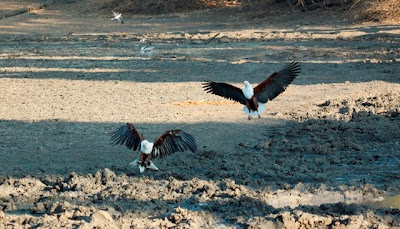Shelly Cox, African Bush Camps
PHOTOS: Tammy Smith, African Bush Camps
The dry season in Africa provides a harsh environment,demonstrating the survival of the fittest for all species including birdlife, which flourishes in Mana Pools National Park.
Kanga Pan, located inland of the Zambezi River, is the only water source in the area year round, providing a formidable stage for travellers,wildlife fanatics and birdwatchers to experience up-close-and-personal encounters with species battling to survive the dry months of August through to November.
In September 2013, our team at Kanga Camp captured incredible photographic footage of the daily spectacles which can be experienced inland of the Zambezi River.
Two resident fish eagles had been living off the smaller catfish species inhabiting the pan in front of camp. Equipped with powerful talons to enable the eagle to grasp slippery aquatic prey, these eagles had been successful in their hunting over the previous months.
Whilst this species mainly subsists on fish, the fish eagle is opportunistic and may take a wider variety of prey, such as waterbirds. As the water in Kanga Pan slowly began to recede and marabou storks depleted the catfish numbers, leaving only the larger fish which the eagles battled to carry in their talons, the competition for food increased.
Maribou Stork
With only the largest of the catfish left in the pan’s muddy waters, and after several unsuccessful fishing attempts, the two eagles resorted to feeding on doves that would frequent the pan in the early mornings to drink
Fish eagle in water
On the morning in question, guests were having breakfast looking out over the pan watching the two fish eagles sitting up in a nearby tree. Suddenly in a swoop of feathers and talons, the two eagles fell upon a juvenile sparrow hawk which had been drinking from a small puddle
The resident eagles
A battle between the two eagles ensued over the impending meal and guests watched in awe as the two majestic birds fought for the day’s sustenance
The battle begins
Finally one of the fish eagles made a break and took off with the sparrow hawk securely in its talons. Resting in the safety of a tree on the outskirts of the pan, the successful predator was left to feed on its prey
Factfile
- Despite only one in every seven or eight fishing attempts being successful, the African fish eagle rarely spends more than ten minutes per day actively hunting.
- Calling and duetting, whilst perched or soaring, is an integral part of the breeding display, and is combined with dramatic aerial dives and falls, with pairs interlocking talons in mid air.
- The female normally lays one to three eggs, which are incubated for around 44 days before hatching.
- In the wild those fish eagle young that are fortunate to survive the first year have an estimated life expectancy of 12 to 24 years.
- The estimated current population size is 300,000. The species remains widespread throughout sub-Saharan Africa in suitable habitat and is not considered to be threatened.








No comments:
Post a Comment